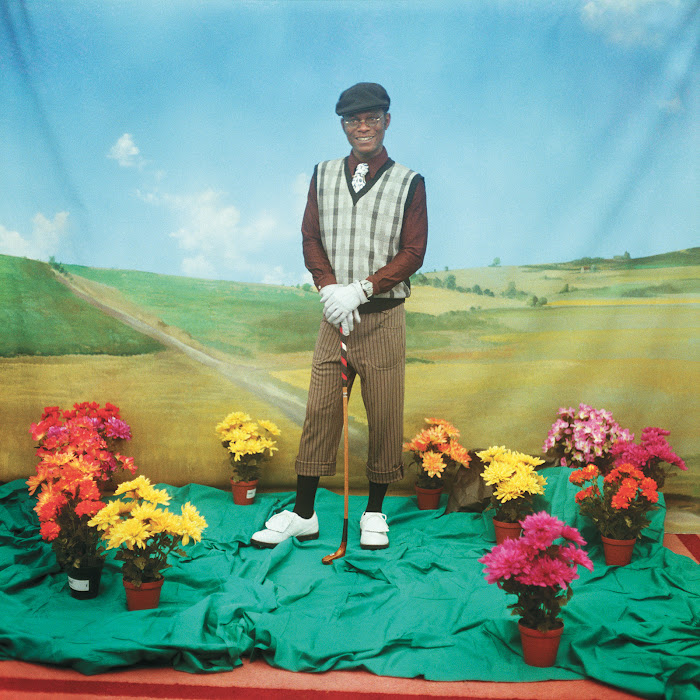Samuel Fosso was not photographed until he was ten. As a child, he was partially paralysed until the age of three (after he had been thrown off the roof of a building by a healer which, again, was arranged by his very grandfather who had also been a healer) making his father believe that having the portrait made of a disabled child "might be a waste of money". The absence of the photographs and the Biafran Civil War, which broke out when Fosso was five, left a void in his formative years (via and via).
Above: "The Chief (who also sold Africa to the colonists)", Fosso's best shot: "This is the best. I am an African chief, in a western chair with a leopard-skin cover, and a bouquet of sunflowers. I am all the African chiefs who have sold their continent to the white men. I am saying: we had our own systems, our own rulers, before you came. It's about the history of the white man and the black man in Africa. Because they may try to cover it up these days, you know, but underneath it's still the same." Samuel Fosso
Photography became both a space of self-enunciation and a space of refuge as a child exile in the Central African Republic. The studio became the space where he could establish symbolic lines of communication with home. That’s what led him to turn the camera on himself.
Chika Okeke-Agulu
Above: "The Liberated Woman of the '70s"
Fosso's photographs might have started as self-portraiture - and, in his early years, he used to play "with a pleasant form of narcissism, common in adolescence" but they soon became performance and photographic masquerade, "a place to explore the spaces where history, politics, religion, and culture mingle and merge", a way to examine aspects of Black identity (via and via) and, as Fosso says, "a form of therapy that has enabled me to bring about a sense of self and tell the world that I exist, that I am here. Self portraits give me the opportunity to engage with my own biography." (via)
One unifying theme behind all my self portraits is the question around power. I want to express the idea that a person who is not free is not alive.
Samuel Fosso
Above: "The Golfer"
Africa was arbitrarily divided into countries by European colonialists. I wanted my studio to reflect my desire to create a sense of pan-African unity and identity.
Samuel Fosso
Above: "The Pirate"
Fosso uses photography as a tool of postcolonial critique to examine the interconnectedness of modern life through the dual lens of Pan-Africanism and foreign influence from both the East and the West. While many critics have focused on the aspects of gender and sexuality in Fosso’s work, Okeke-Agulu points to a much deeper line that runs through his practice: the fundamental issue of displacement he experienced in his youth. (via)
The yearning to return home is one of the most powerful motivations for him as an artist. His art was one of the only avenues to accomplish that homeward journey,” Okeke-Agulu says. “There is a ritualistic aspect of acting that is important to him. The masquerade is not simply about the physical performance, it is also a philosophical and spiritual connection to imagined communities in his hometown in Nigeria, or the Pan-African world of Blackness – a quest to return home that he did not accomplish until 2015 when he moved his family back to Nigeria and built a studio there.
Chika Okeke-Agulu
- - - - - - -
photographs (series TATI) via
“That’s how my Tati series (1997) began, because I did not want to go back to the black-and-white style as Keïta and Sidibé had done for their Tati commissions. Since there were three African photographers, I wanted my project to register a different mood of the African imagination, and not the images that were already associated with African photography. My goal was to take a new direction in my work.” Samuel Fosso


























Wow! Really wow!
ReplyDelete" The Chief (who also sold Africa to the colonists", love both the photograph and the title. Thanks, Abbie!
Delete